St Martin of Tours, the Merciful – Nov 12 Glory of Gaul
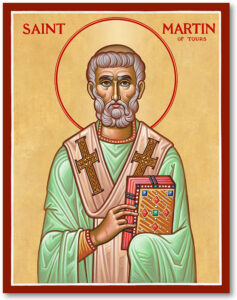
Martin the Merciful, was a bishop of Tours in the fourth century. He is called the Merciful because of his generosity and benevolence, care and concern for the poor. Martin was born in 316 or 317 in Sabaria, Pannonia, today’s Hungary, in a pagan military family. His father was a tribune in the Imperial Horse Guard and was stationed in Ticinum, Cisapline Gaul, which is modern day Pavia, Italy. Later the family returned home to Italy, where Martin grew up. He saint showed interest in Christianity at an early age. He loved Christ with all his heart. He began to go to Church at the age of ten, and became a catechumen. He desired to become a monk, but he entered the army in obedience to his parents, at the age of 15. Even as a soldier never shirking his military duty, he lived more like a monk, praying and fasting, than like a soldier.
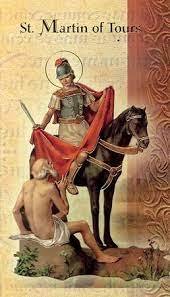
One day, when he was stationed in the Roman Cavalry, at Amiens in Gaul, on his rounds he met a poor man, begging, poorly clad, almost naked and shivering for lack of clothing. Martin felt sorry and sad at this. He saw that many passed but no one stopped to help him. He slowly let his fellow soldier friends go ahead. He had already given all his money as alms, and had nothing but the clothes he wore. So, he drew his sword, cut his soldier’s cloak in half, and gave half of it to the poor man and wrapped himself in the other half. That night Christ appeared to him, clothed in the half-cloak he had given away, and said to His angels, “Martin, though still a catechumen, has clothed me in this garment.” Martin was baptised soon afterward. Though he still desired to become a monk, he did not obtain his discharge from the army until many years later, in 356.
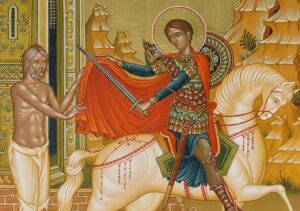
Martin left the army service in the Roman army, at the age of 18 and was baptized and became a disciple of St. Hilary of Poitiers who was prominent in the trinitarian disputes with the Arians. When he was 21, a war broke out against Gaul. Emperor Julian called back all their soldiers to war offering a huge war bounty. All his friends joined, but Martin refused saying. “I have served you as a soldier, now I want serve Christ. Give the bounty to others, I am a soldier of Christ, it is not lawful for me to fight”. He went back to Pannonia and he converted his mother and few friends to Christ, but he could win his father.
It was Martin’s desire to pursue his religious calling in solitude with the Lord. His friend gave him a piece of unused hilly land. This site was enclosed by steep cliff on one side and river Loire on the other. There he founded the Monastery Marmoutier, outside the city of Tours, on the opposite the Loire River, where he led an austere life with cave dwelling cenobites. He was tonsured as a monk and led a truly strict ascetic life.
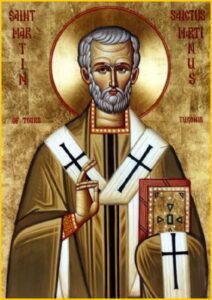
Many, including those from noble families, followed St. Martin and in the same manner, fashioned retreats for themselves, in the dwellings formed out of the rock of the overhanging mountain, hollowed into caves. They built wooden cells to live and some lived in the caves dug out of the rocks. About eighty disciples, disciplined their life after their saintly master. No one had anything which was called his own; everything was common. They were not allowed either to buy or to sell anything. The younger monks practiced as transcribers, while the elders spent their time in prayer. Very rarely they left their cell, except when they assembled at the place of prayer. They always dined together, after the hour of fasting. No one used wine, except when illness compelled them to do so. Most of them were clothed in garments of camels’ hair. Soft attire was deemed criminal, even though many were from noble rank. This monastery became a center of monasticism not only for Gaul, but for all of Western Europe.
He lived for ten years in his monastery. He was acclaimed bishop of Tours in 371, following the death, the Bishop of Tours, when the people of Tours and neighboring bishops forced him to accept. He visited his parish on foot or on a donkey.
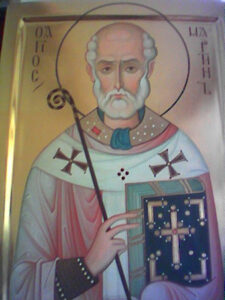
God gifted Martin with power of working miracles and driving out evil spirit. He performed many miracles. As death approached, Martin’s followers wept and begged him not to leave them. He prayed, “Lord, if your people still need me, I do not refuse the work. Your will be done.” St. Martin of Tours died on November 8, 397, at Candes and buried three days later. Two thousand monks and nuns gathered for his funeral. Many Churches have been dedicated to him, all over the world in the Roman Catholic and Eastern Orthodox. He is commemorated by the Eastern Orthodox Church on November 12.

0 Comments